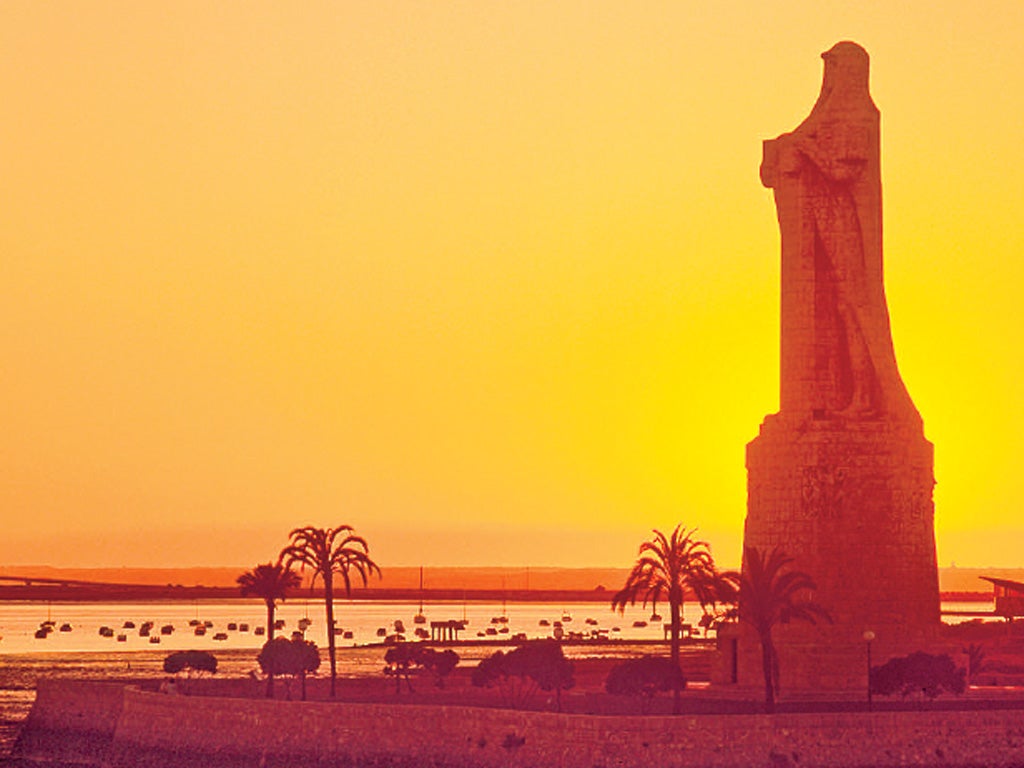
Huelva
Spain's maritime gateway to the Americas is a city of explorers that deserves discovery. Founded by the Phoenicians and expanded by the Romans, the port city of Huelva has some fine buildings. They include a Renaissance cathedral, and an area built in the suburban English style of the early 20th century to house the British engineers working at the nearby Rio Tinto mines. But its most striking monument, about a mile or so south of the city centre, is a stone statue that dominates the port. Representing the figure of a monk leaning on a cross (below), it commemorates Christopher Columbus, who set out from here to discover the New World.
The explorer came to the area – in particular the La Rábida monastery, perched on a hillside overlooking the port – to meet the prior, Father Marchena, who was to help him arrange funding for his journey.
Modern visitors to the monastery can see the chapter house where their meetings took place, and the church where Columbus prayed before he set sail. Replicas of the three ships that formed his expeditionary force are moored in an artificial lagoon below the monastery.
Almería
The furthest east of Andalucía's major cities, Almería is also the driest and warmest, with winter temperatures nudging 20C. It's a thriving port on a large bay, whose strategic position explains the defensive aspect of its two major sights.
The Alcazaba is the dominating fortress, which dates from the 10th century. Built on three levels and much restored, it's worth visiting for the views alone. The nearby sandstone cathedral is also designed to repel invaders, in this case Berber pirates, with the help of its bulging walls, small windows and a flat roof to accommodate cannons. It was built after an earthquake destroyed the original cathedral, along with much of the rest of the city in 1522.
Inland from Almería, Europe's only semi-desert provides a landscape of dramatic sandstone, straight out of a cowboy film, which in fact they are. Three sets that Sergio Leone used for his spaghetti westerns have been repurposed as theme parks (below). The largest, Fort Bravo boasts a wild west town, Mexican pueblo and a native American camp. It's 2km south of Tabernas on the N340a (open daily 9am-7pm; €16.50).
Jaén
Guests at the Parador in Jaé* can sit on the terrace and admire some of the finest scenery in Andalucía: rocky hillsides and swathes of neat olive groves. Jaé* is the centre of a flourishing olive oil industry. Now a luxury hotel, the imposing building began life as a fortress built by the Moors to defend a hilltop site that had great strategic importance in keeping out attackers.
An attractive city is tucked far below the castle. Here, traces of Moorish life were driven underground. In Renaissance times a mansion, the Palacio de Villardompardo, was built on top of the largest Moorish baths in Spain; these have now been restored to their original 11th-century splendour. The palace above is used to house the Museum of Art and Popular Traditions, an interesting depiction of life in a bygone age.
Jaén's finest monument, the cathedral, was built on the site of the main mosque. It's the masterpiece of Andrés de Vandelvira, a prominent Andalucían architect of the 16th century, who was responsible for many fine buildings in the area.
Ubeda and Baeza
Often bypassed in favour of the Andalucían cities, the exquisite little towns of Ubeda and Baeza are worth exploring for their own special characteristics. Both flourished during the Renaissance, when some of the finest architects of the period set to work, and even now it is possible to stroll through the ancient streets and imagine life as it must have been during the heights of the 16th century.
Ubeda (above left) is dominated by magnificent buildings that resulted from the patronage of local dignitaries. The Hospital de Santiago, the Palacio de las Cadenas, the Sacro Capilla del Salvador and Iglesia de San Pablo were all built by Andres de Vandelvira, one of the best-known Renaissance architects. He also designed the cathedral and the convent of San Francisco in Baeza (above right), a town that boasts remarkable golden sandstone architecture.
Vestiges of the Moors remain in both towns. They were responsible for the city walls enclosing Ubeda's old quarter, and in Baeza there are traces of Mudéjar architecture – Moorish style created by Christian architects – seen to most striking effect in the ceiling of the main hall of the old university.
Subscribe to Independent Premium to bookmark this article
Want to bookmark your favourite articles and stories to read or reference later? Start your Independent Premium subscription today.

Join our commenting forum
Join thought-provoking conversations, follow other Independent readers and see their replies